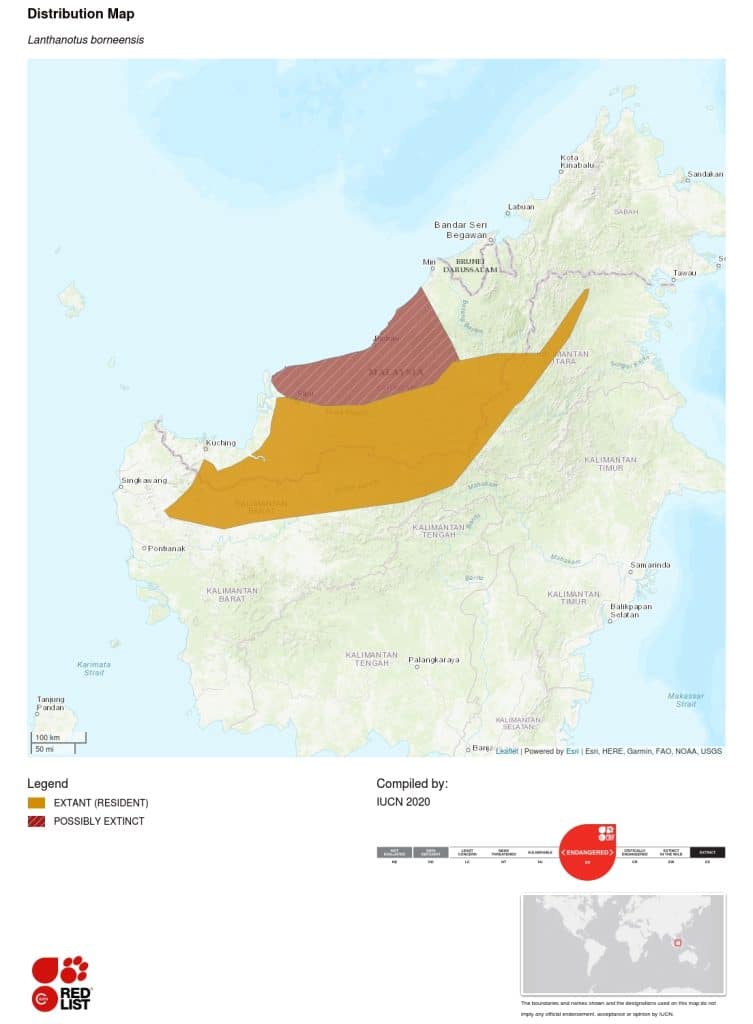With the last common ancestor diverging in the Cretaceous period, Borneo’s endemic dragon-like living fossil – the earless monitor lizard – still mesmerises herpetologists and animal lovers worldwide.
—
Taxonomy
Class: Reptilia
Order: Squamata
Superfamily: Varanoidea
Family: Lanthanotidae
Genus: Lanthanotus
Species: Lanthanotus borneensis
Geography
Subcontinent: Southeast Asia
Countries: Malaysia, Indonesia
Native habitats: Lowland rainforests, near streams
Size of Adults
Length: 20-25 cm (snout-to-vent) and 40 cm (total)
Weight: Approximately 0.5 to 1.5 kg
Borneo (in Malaysian), or Kalimantan (in Indonesian), is the third-largest island in the world. Considered one of the most beautiful landscapes in Southeast Asia, Borneo is also a home to an impeccable diversity of rare wildlife species, like the Borneo orangutan (Pongo pygmaeus), Sumatran rhinoceros (Dicerorhinus sumatrensis harrissoni), the sun bear (Helarctos malayanus), the eight-banded barb (Eirmotus insignis), the Borneo pygmy elephant (Elephas maximus borneensis), the Rhinoceros hornbill (Buceros rhinoceros), and many others.
Among them, the special place holds the bizarre-looking lizard species – Borneo Earless Monitor (Lanthanotus borneensis). Being the sole living species in the Lanthanotidae family, it shares its lineage with true monitor lizards. This species stands alone without any contemporary counterparts, and its most recent common ancestor is believed to have diverged in the Cretaceous period, around 145 to 66 million years ago.

Appearance and Habitat
One of the most striking features of this exotic lizard is its prehistoric look and resemblance to a miniature flightless dragon or dinosaur. They lack ear openings (hence the name), but they can hear. The lizard also exhibits an elongated body with a relatively long neck, accompanied by small limbs. The blue eyes are magnificently contrasting with brown armoured skin, making the lizard even more enigmatic.
The lizard is semi-aquatic, preferring to live near streams and marshes in lowland rainforests, as well as in anthropogenic habitats like agricultural land, mature fruit tree gardens, and palm oil plantations.
This species is also known to potentially occur in rice paddies. The streams it populates are typically rocky. Its tropical habitat maintains air and water temperatures ranging from approximately 22-29C (71.6-84.2F), with captives reportedly preferring temperatures between 24-28C (75.2-82.4F). In areas densely populated by earless monitor lizards, the water is clear with a neutral acidity (pH). This species also shares microhabitats with Tropidophorus water skinks.

Diet and Behavior
The species is known to hunt earthworms, freshwater crabs, and catfish. Additionally, in captive conditions, individuals have demonstrated a preference for chopped red meat, fish, and frogs. Other dietary preferences include insects like crickets, cockroaches and grasshoppers.
While generally docile and inactive when handled, male earless monitor lizards exhibit more aggression than females. Despite historical dissection studies initially suggesting an absence of venom, a 2020 study has identified venom glands and toxic compounds, primarily kallikreins, in their bites, although the venom’s blood-clotting effects are comparatively weaker than those of many other venomous reptiles.
Population and Conservation Status
Borneo Earless Monitor is an extremely rare animal due partly to its reclusive lifestyle. It has been categorised as ‘Endangered’ by the IUCN Red List of Threatened Species. Only about 150 specimens were collected over a century and a half from fewer than 15 confirmed localities. Several habitats may have been lost due to deforestation, resulting in the surviving population being severely fragmented. While the true area of occupancy is unknown, recorded occurrences correspond to an area of approximately 52 square kilometres (20 square miles).
The rarity and mystery surrounding this animal have led reptile enthusiasts to affectionately dub it “the Holy Grail of herpetology.”
Earless monitor lizards face significant threats primarily from human activities, including trapping for the pet trade and hunting for their skin in the leather industry. Additionally, habitat loss poses a severe danger to this species, with Borneo’s rainforests swiftly giving way to the expansion of oil palm plantations.
You might also like: Palm Oil Deforestation: Origins, Environmental Degradation and Solutions

Although the rate of forest loss in the Earless Monitor’s habitat has been slightly below 30% over the past 18 years, the absence of information regarding the species’ generation length raises concerns. The lizard’s dependence on a specific lowland forest habitat, coupled with the elevated risk it faces, suggests that the decline in suitable habitat, and consequently the lizard population, may have surpassed 30% over three generations.
The unique characteristics of the Earless Monitor lizard have sparked considerable international interest in herpetoculture, leading to a demand in the pet trade. This demand escalated rapidly after traders identified potential collecting sites, posing a significant threat to the species as individual subpopulations are believed to be small and vulnerable to collecting pressure.
Featured image: kuritafsheen77/Freepik
You might also like: 10 of the World’s Most Endangered Animals in 2023







